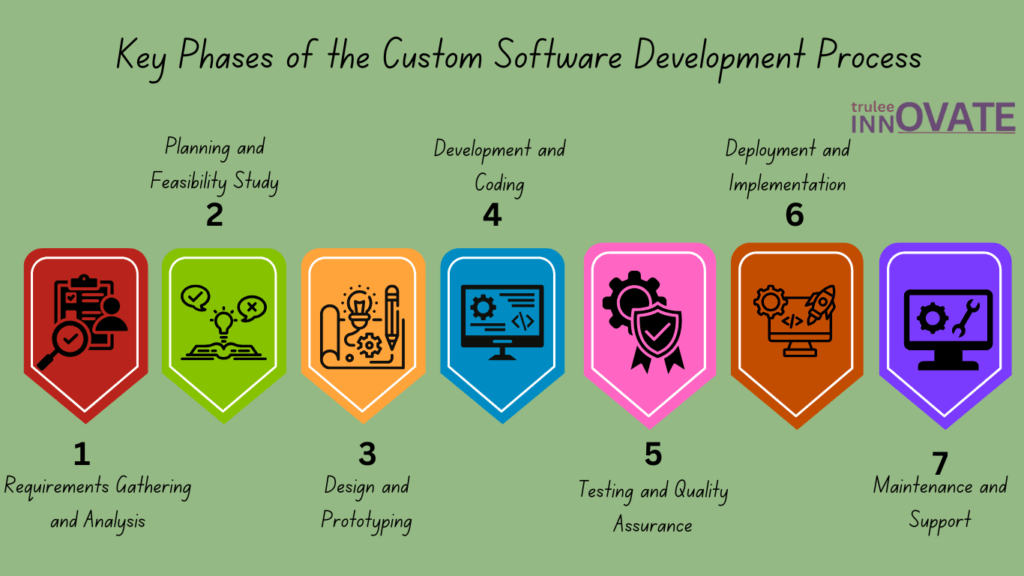Introduction to Custom Software Development
Custom software development process has become a critical driver for businesses aiming to meet unique operational needs and stay competitive in the ever-evolving digital landscape. Unlike off-the-shelf software, which offers generic solutions, custom software is tailored specifically to a business’s requirements, providing a competitive edge.
Importance of Custom Software in Modern Businesses
In today’s market, businesses need software that aligns with their workflows, customer preferences, and long-term goals. Custom solutions help organizations streamline processes, reduce inefficiencies, and address specific challenges that generic solutions cannot handle effectively.
Key Differences Between Custom Software and Off-the-Shelf Software
- Flexibility: Custom software adapts to business needs, while off-the-shelf software requires businesses to adapt to its features.
- Scalability: Custom solutions can grow with the business, whereas off-the-shelf software may have limitations.
- Cost: While custom software involves higher initial costs, its long-term benefits often outweigh the investment.
What is the Custom Software Development Process?
The custom software development process refers to a systematic approach to designing, building, and maintaining software tailored to specific business needs. This process involves several structured phases, ensuring that the final product meets the organization’s unique requirements and goals. By following this approach, businesses can achieve superior performance, scalability, and efficiency.
Benefits of a Structured Development Process
- Clarity: Clearly defined steps reduce ambiguity and improve project outcomes.
- Efficiency: Structured processes streamline development, saving time and resources.
- Quality Assurance: Each phase incorporates checks and balances to ensure the product meets standards.
Custom software development is not just about writing code—it is about creating a solution that fits seamlessly into a business’s operations. By understanding and following the custom software development process, businesses can transform their ideas into tangible, functional applications.
Key Phases of the Custom Software Development Process
Requirements Gathering and Analysis
This is the foundation of the custom software development process. Teams collaborate with stakeholders to understand business needs, define goals, and document requirements.
- Activities: Interviews, surveys, and workshops with stakeholders.
- Deliverables: Detailed requirement documents and workflows.
Understanding the business’s specific challenges and objectives is crucial in this phase. A thorough analysis ensures the software will address key pain points and deliver measurable value.
Planning and Feasibility Study
In this phase, the development team evaluates the project’s feasibility in terms of technology, cost, and timeline.
- Activities: Risk analysis and resource allocation.
- Deliverables: Project plans and feasibility reports.
Proper planning lays the groundwork for success. It ensures that the team has a clear roadmap and identifies potential risks before development begins.
Design and Prototyping
Designers create visual representations of the software, including wireframes and prototypes. This phase focuses on user experience (UX) and user interface (UI) design.
- Activities: Designing layouts, navigation, and prototypes.
- Deliverables: UI/UX designs and interactive prototypes.
Prototyping allows stakeholders to visualize the final product early in the process, providing an opportunity to give feedback and make necessary adjustments
Development and Coding
Developers write the software’s code during this execution phase. This procedure is frequently guided by agile methodologies to guarantee iterative development and ongoing input.
- Activities: Coding, integration, and version control.
- Deliverables: Functional software modules.
The custom software development process emphasizes iterative progress, enabling teams to refine features and address issues promptly.
Testing and Quality Assurance
Quality assurance ensures the software meets all requirements and functions without errors.
- Activities: include performance, integration, and unit testing.
- Deliverables: Bug-free software.
Thorough testing is necessary to guarantee the software’s performance, usability, and dependability in a variety of scenarios.
Deployment and Implementation
The software is deployed in a live environment and integrated with existing systems.
- Activities: Installation, configuration, and user training.
- Deliverables: Fully operational software.
A smooth deployment process minimizes downtime and ensures that users can quickly adapt to the new system.
Maintenance and Support
Ongoing maintenance guarantees that the program stays current and functional after deployment.
- Activities: Updates, troubleshooting, and enhancements.
- Deliverables: Continued support and optimized performance.
Regular updates and proactive support are vital for addressing evolving business needs and technological advancements.

Best Practices in the Custom Software Development Process
Agile Methodology and Its Role
Agile development promotes iterative progress, adaptability, and collaboration, ensuring the product evolves according to user feedback.
Collaboration Between Teams and Stakeholders
Effective communication between developers, designers, and stakeholders minimizes misunderstandings and fosters alignment with business goals.
Prioritizing User-Centric Designs
Building software with the end user in mind improves usability and satisfaction, ensuring the product delivers real value.
Challenges in the Custom Software Development Process
Common Pitfalls to Avoid
- Unclear Requirements: Leads to scope creep and inefficiencies.
- Poor Communication: Results in delays and misaligned expectations.
- Insufficient Testing: Increases the risk of bugs and errors post-launch.
How to Overcome Development Roadblocks
- Invest in Clear Documentation: Ensure all requirements are well-documented.
- Use Project Management Tools: Tools like Jira or Trello can streamline workflows.
- Conduct Regular Testing: Catch issues early to avoid costly fixes later.
Tools and Technologies Used in Custom Software Development
Popular Software Development Tools
- Integrated Development Environments (IDEs): Visual Studio, IntelliJ IDEA.
- Version Control: GitHub, GitLab.
- Testing Tools: Selenium, JUnit.
Emerging Technologies Shaping the Process
- AI and Machine Learning: Enhance automation and analytics.
- Low-Code Platforms: Speed up development without compromising quality.
How to Choose the Right Partner for Your Custom Software Development
Evaluating Expertise and Experience
Assess the provider’s portfolio, technical expertise, and industry experience to ensure they can meet your needs.
Importance of Communication and Transparency
Look for partners who prioritize clear communication and provide regular updates on progress.
Real-World Examples of Successful Custom Software Development Projects
Case studies highlight how businesses have leveraged the custom software development process to solve unique challenges and drive growth.
Future Trends in the Custom Software Development Process
The Role of Artificial Intelligence and Machine Learning
AI-driven tools are transforming how developers create and optimize software, enabling faster and smarter solutions.
Predictions for the Next Decade
- Increased adoption of cloud-native development.
- Greater emphasis on cybersecurity in software design.
- Expansion of IoT-enabled custom solutions.
Conclusion: Why Understanding the Custom Software Development Process Matters
A deep understanding of the custom software development process empowers businesses to create tailored solutions that drive efficiency, innovation, and success. By following a structured approach and partnering with experienced developers, organizations can unlock the full potential of custom software.


